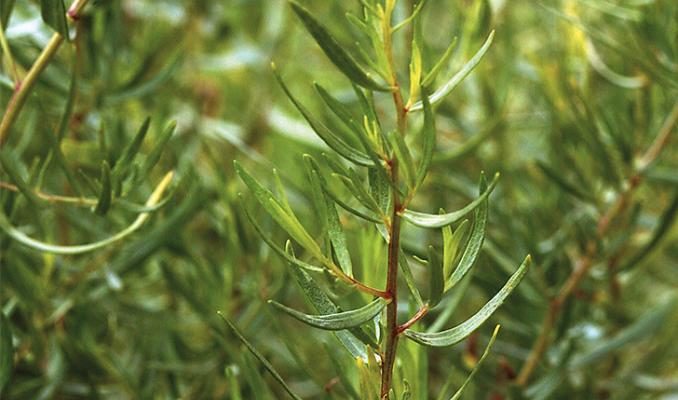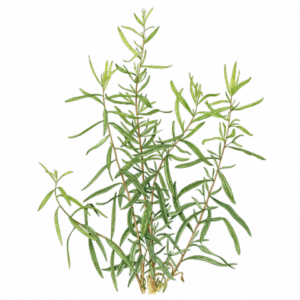
Find out more about the Tarragon plant of our Aromatherapy Herbarium blog series.

TARRAGON
Artemisia dracunculus
DESCRIPTION

Tarragon (Artemisia dracunculus), a bushy perennial, with many highly branched stems and thin leaves, belongs to the Asteraceae family.
ADVICE
Essential oil of tarragon is remarkably well-tolerated. For cooking, one or two drops of essential oil are enough to perfume a dish for five to six persons.
DO NOT USE IN
– pregnant or breast-feeding women,
– children under the age of six years,
– persons allergic to one of the components (limonene),
– subjects with asthma without the advice of an allergologist before the first use,
– persons whose professional activity requires vigilance.
RECIPES
Allergic asthma
- Apply three times daily 5 drops of essential oil of tarragon mixed with 5 drops of vegetable oil on the chest, solar plexus and spinal column.
- Breathe 4 drops of essential oil of tarragon on a handkerchief.
Digestion
Take three times daily and for a maximum duration of six days, 1 drop of essence of lemon and 1 drop of essential oil of tarragon on a neutral tablet, in a spoonful of olive oil, honey or on a sugar lump. (Not suitable for children under the age of twelve years.)
Hiccough
1 drop of pure essential oil of tarragon under the tongue to be repeated five minutes later, if necessary, and the spasms disappear. Consult your doctor if the hiccough is abnormally persistent.
Hay fever
Apply 5 drops of essential oil of tarragon mixed with 5 drops of vegetable oil on the sides of the nostrils and the temples.

It is a native of the Central Asia steppes. Propagation is carried out by division of clumps and cuttings. There are several Artemisia species (annua, arborescens, herba alba, pallens).
Both the Latin and common names of tarragon derive from its real or supposed virtues. In the Middle Ages it was believed that its root looked like a dragon (drakonion in Greek), and it was thought to be effective against snake bites, and was called tarragon, dragonne, herbe à dragon or serpentine. It is Artemisia because like the goddess Artemis, protector of women, it cures gynaecological ailments. The plant was introduced in Europe by the Moors of Andalusia with the name of tharkoum, and was described for the first time by the great Arabic botanist of the 13th century Ibn el-Beithar in his Collection of simple. He considered as a precious digestion auxiliary. Tarragon occupies the seventh position in the French aromatic plant production. It is used as a condiment in many preparations (flavoured vinegar, mustard, sauce Bearnaise, etc.).
CULTIVATION AND PRODUCTION
In Provence, tarragon is traditionally cultivated for perfumery, only small surfaces are dedicated to aroma therapy. Tarragon has a reputation of being difficult to cultivate and cannot survive in wet soil during winter. The plant is harvested in June and September. Harvest must take place in the afternoon in good weather for the best yield.
FRAGRANCE
The odour of essential oil of tarragon is strong and slightly sour.
EXTRACTION AND YIELD
The flowering herbs are distilled in a pot like for hybrid lavender. In this fast technique, the plant is ground at the time of harvest, and the farmer can connect a full “pot” to a distillation device himself. A cultivated hectare yields on average eight tonnes of fresh plant, which give thirty to fifty kilograms of essential oil, i.e. a yield of approximately 0.5%.
CHEMICAL FORMULA
The active ingredients of essential oil of tarragon are principally methyl-ethyl phenols (chavicol M.E.) and coumarins which are not present in all batches, but may reach between 1% and 3%.
MAIN INDICATIONS
Tarragon is a digestive tonic. It opens the appetite, and is not just, as it is often believed, an effective remedy for digestive disorders, including colitis and aerophagia. A potent antispasmodic, it also fights respiratory allergies, rheumatism and menstrual (dysmenorrhoea) pains, neuritis and polyneuritis, cramps and various spasms (hiccough).


Leave a Comment